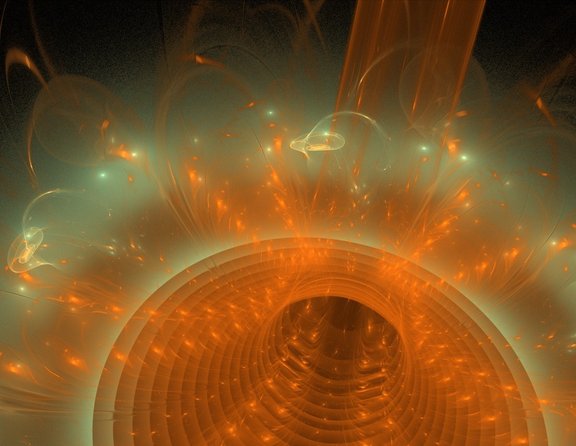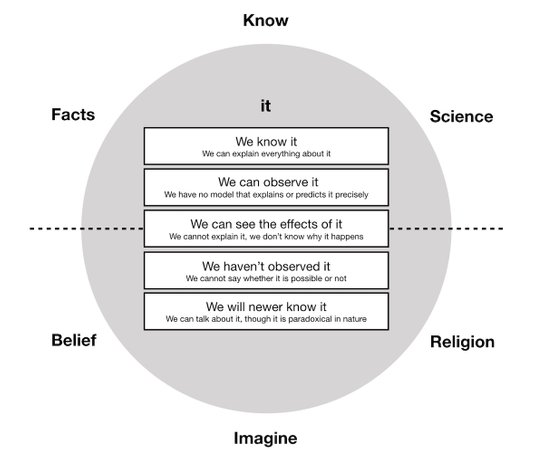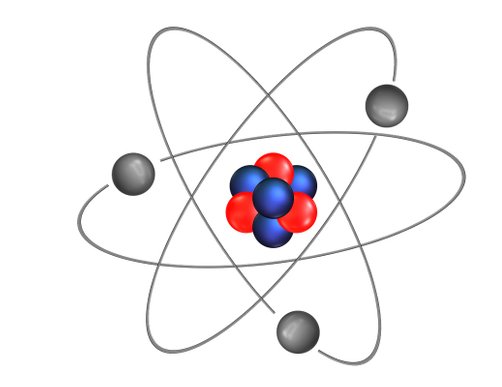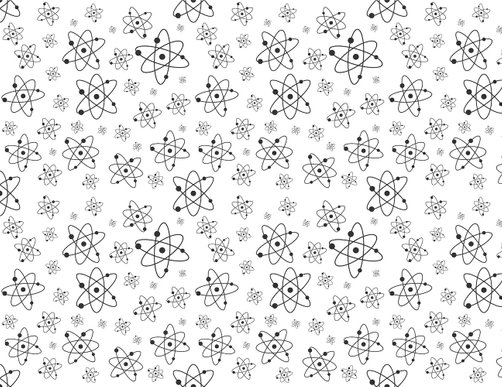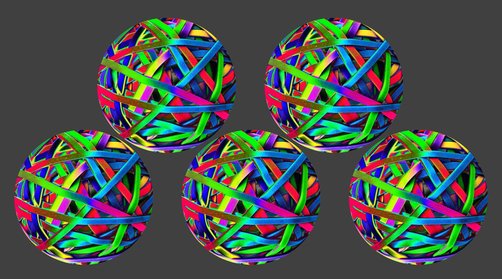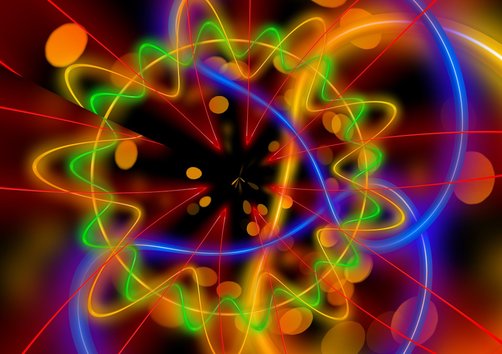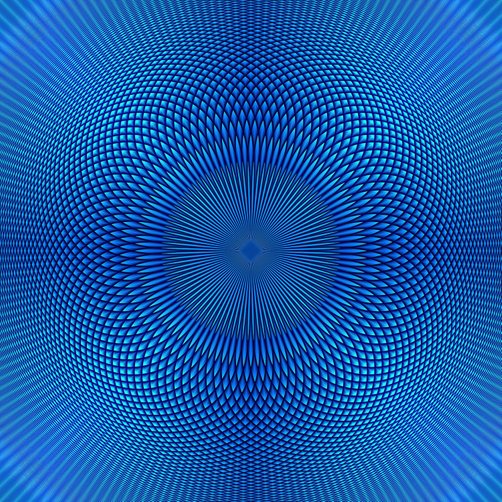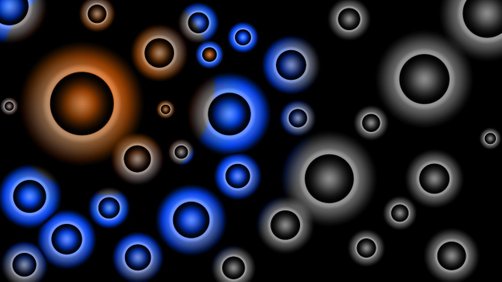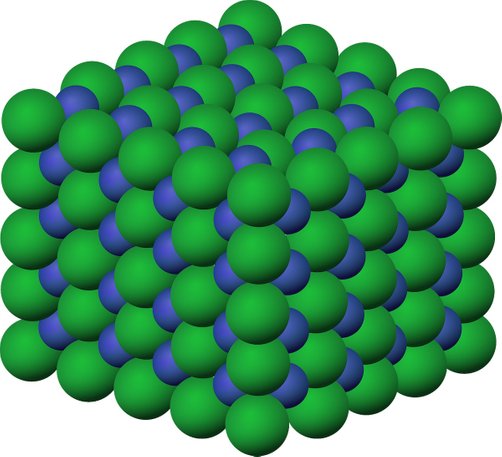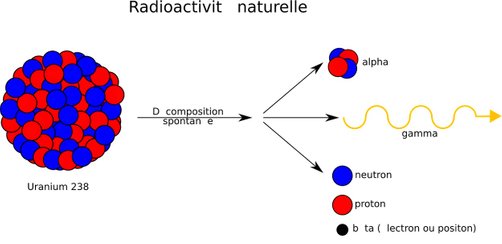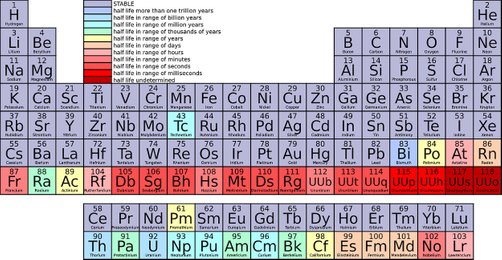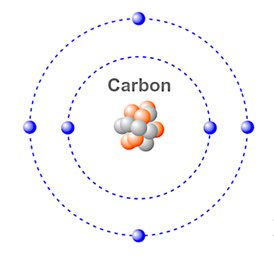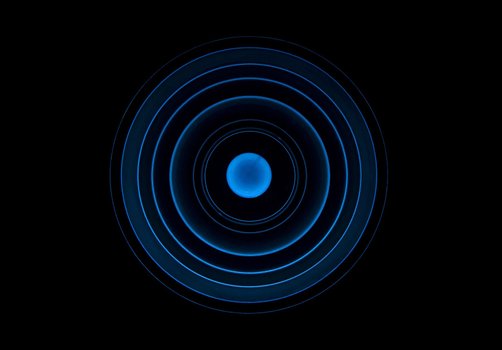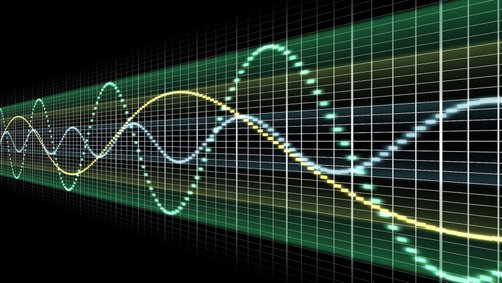The Quantum Realm
The science of physics is about all that. The DNA of every physicist is about wanting to know everything about the inner workings of the Universe, what stuff is made of, and why objects are behaving and reacting the way they are. The primary tool - and product - of the science of physics, is the scientific theory.
A scientific theory is something completely different than speculations and imagination. When we say that our theory can explain something, what we mean is that for all we know, the theory matches the observations, and has even shown the strength to be able to predict the outcome of experiments that we haven't done yet. Science is the opposite of Religion. Science will never take upon itself to construct a theory that, for instance, would try to explain the existence of God. Because if the entity in question has no physical representation, and there is no way you can register it, and no possible way of performing experiments on it, it is not of scientific interest.
This is not said in any offensive, or judgemental way. In fact, many scientists are also religious. The point here is, that there are only so many questions that science can help answering. And the rest is something each of us decide ourselves, how to deal with.
But physicists gladly takes upon themselves the challenge of theorizing about time, other dimensions, the rules that governs the Universe and the internal structure of everything that we are and what surrounds us?
The greatest paradoxes of all, are hiding in the answers to these questions. At first it may seem abstract and not rooted in common sense. But it actually is. And the epiphany that stems from this, is nothing short of beautiful.
Below are 6 short articles, on 6 essential physics topics, written in a way so that you don't have to be a mathematician or physics student to understand them.
Be aware that they represent theories, and not facts. Because the topics discussed here will never be proven, because they are on the borderline between physics and philosophy, and you might even argue, religion.
if you wonder about these topics, and believe that simplicity is the ultimate sophistication, then you will be enlightened and pleased by this, and be grateful for this insight - I sincerely am.
THE FABRIC OF SPACE: And everything else
Physics is probably the most abstract science discipline to grasp, for most people. If you are one of those people, you might see no reason to spend time getting to know more about this - because you don't see any benefit coming out of that effort. I'm not one to disagree with you. But I will tell you this; physics lays the foundation for all natural science disciplines, and the physics models and theories establishes the foundation for getting any kind of meaning and insight into the other sciences.
The Atoms and Beyond
Everything is build from something else... right. Right?
Houses are build from bricks. Bricks are build from sand. Sand is build from Silicon atoms. Atoms are build from Protons, Neutrons and Electrons. Protons are build from Quarks. Quarks are build from .... eh ... well we really don't know.
But we are asking the wrong question here. The question we should really be asking is, how can it even be true that everything is build from something else?
This is exactly the same paradox as we were confronted with, when talking about "what is outside the universe". The way our minds work, this is a straight forward question, and our mind demands a god explanation. But in reality, the logic breaks down. The universe has to be infinite. Because a contradicting answer would be pure nonsense.
Back to the building blocks. The same line of reasoning tells us - if we loosen up, and put aside our prejudiced opinions - that there has to be something wrong with this line of reasoning. It has to stop.
Of all the paradoxes presented in this article, this might be the toughest one to digest.
We could think that there is space, light and then there is everything else. But it gets even more weird. Because most likely - of course we will never know for sure, because the things we are talking about here can never be proved, only theorized - all there is, is the fabric of space. And the rest - light, atoms and particles, gravity and electromagnetic fields, bricks, cars, birds, taste, love, you and me - are merely ripples in the fabric of space. Well organized ripples, well functioning and with somewhat clear boundaries, interacting in very complex, deterministic ways determined by the laws of nature. But only existing as ripples.
Space is like an elastic fabric, that has elastic properties, but is not consisting of anything. If it is not vibrating, there is nothing there, but the fabric itself. If it is vibrating, things come to life, objects are manifested, and interactions can occur.
Try to compare it to the ocean, waves and drops of water. This is all just water, but still in three different manifestations.
The are no discrete objects, nothing can be considered in isolation. The ripples of the surface of the water is a consequence of the distribution of pressure in the water as a whole. And the wave-tops exerts forces back on the rest of the water masses. The waves are not an object that is separate from the still water. The waves and the still waters exists in combination, they are one.
Now try to imagine an elastic fabric filling out space in all 3 dimensions, infinitely. Elastic in the sense that if you try to deform it, compress, bend or stretch it, it will resist the deformation and a force - the elasticity - will try to flatten the space again. The easiest way to visualize this is, by using the analogy of a rubber band. If you stretch it, and remove the stretching force again, the rubber band will shrink back to its "basis size".
Important note here, before we move on. This deformation force that I'm mentioning, is in reality not a force that acts on the fabric from outside-in. The force that deforms the fabric is ripples, or waves, moving through the fabric, originating from vibrations of the fabric, from near or far away. Again, an analogy is the most easy way to explain this - namely music. The reason you can hear the music from a guitar player sitting 10 meters away from you, is because the guitar starts vibrating the air next to the guitar. These vibrations makes the neighboring air molecules vibrate, and so it goes - all the way until the air molecules inside your ear finally vibrates. And then you hear the music. The same goes with the fabric of space, that will be deformed because of deformations started elsewhere. No one is grabbing the fabric. The fabric deforms, stretches and contracts, simply because it is reacting to the movements of the fabric in its surroundings.
A final important point, before we move on. And this can be a bit hard to visualize, but stay with me. If you have a 3 dimensional space consisting of an elastic material - let's say an elastic gel - and the elasticity strength of the material is very high, then it will actually be possible to initiate a 3-dimensional vibration that will be self-sustaining. For example in the form of a sphere, oscillating in and out - with its radius growing and shrinking, growing and shrinking, growing and shrinking...
(just like in the 1 dimensional scenarium, with a pendulum made of a heavy weight and a rubber band, moving up and down, up and down indefinitely).
Now extrapolate this mechanism to the 3 dimensional world. Here all points in space, at the infinitely small scale, can be in either of 3 states (in each of the 3 dimensions). Neutral, Stretched or Pressed. And if it is stretched, it will try to oppose this, and try to contract its surroundings. And if it is pressed, it will try to oppose this, and execute a force that resists this pressure. The result can be a sphere, cyclicly expanding and reducing in size, around a certain equilibrium circumference.
(By the way, just so you didn't get the wrong impression. There are no "points" in space. Space is a cohesive, homogeneous fabric, with the ability to be stretched and pressed, without ever breaking).
After this initial frame-setting, let's move on to the juicy stuff.
In a 3D elastic medium - i.e. space - multiple self-sustaining oscillation-patterns will be possible. This also means that multiple objects (quarks, atoms, particles, whatever we like to call them), can be created, have equal size, and yet still be completely different in their oscillation patterns. This is represented by the illustration showing a perimeter with 3 different "wave patterns" - green, yellow and red.
The elasticity of space will determine how small stable objects can be. If you try to create objects smaller than that, they will only live for a limited time, and then decay into wave flukes that will propagate outwards, and potentially out there to the rim of the known Universe and beyond.
If the oscillation pattern is stable for a time, we call it a particle. When the particle for some reason dissolves, we call it decay or fission or some other term that tells us that the particle has now been transformed into something else, and the original particle is no longer there.
Next, let's look at forces that acts between particles, small and large. When a particle is oscillating in the way explained above, the oscillations are also felt in its surroundings. Remember that it is every part of space that is elastic, and each time a part of space is stretched, this stretching propagates in all directions (like when you stretch a 1 dimensional rubberband, all parts of the rubberband feels the stretch). But please also remember from the discussion above, that this stretching throughout the universe does not happen instantly, but "only" at the speed of light. In reality, what this means is that around the particle, in all directions, waves propagates outwards. And the frequency and wave pattern of these waves are determined by the oscillation pattern of the particle.
Some of the waves will have the ability to - or the effect that they will - attract other particles in the direction towards the source of the wave. An example of these would be the gravitational force, or the electromagnetic force. Other wave patterns have other effects and consequences on its surroundings. This results in other types of forces such as the so-called weak nuclear force and the strong nuclear force. These are the explanations for why particles decay or stick together, in a strong grip, not gliding away from one another, and yet not merge nor destroy one another. These two forces only works at a limited distance, and should be considered as interference patterns between close by particles, more than an actual wave.
If the oscillation pattern is stable, self-sustaining and durable, we end up with a particle or atom.
If the oscillation pattern is unstable, or if some waves or oscillations originating from somewhere in its surroundings, are interferring with it, the atom might eventually break down, into smaller particles or even be converted completely into light (called electromagnetic radiation). The new particles, atoms and radiation are equally made of space fabric oscillations - just with their own, distinct pattern.
I hope it's all starting to be more clear to you.
Now that you hopefully have gotten an understanding of the concept presented here - that particles are not build by various materials, but that particles are simply an oscillation pattern of an elastic space - let's try to zoom out.
If particles has the right, sustainable oscillation pattern, they become resilient and durable. Particles can exhibit forces from one another, and these forces can keep the particles in "bundles" or "compositions" of certain kinds. These compositions are what we call atoms, molecules, metals, salts, fluids and so forth, depending on the type of bonds holding them together, and the structure they obtain in combination.
So when you look around in your living room, all the materials that you see, are actually composed of an incredible huge number of individual, space-oscillating particles aggregated into structures, and bound together to compose various materials. And the same goes with your body, your computer and everything else you can see, feel or smell.
Now find a metal surface, put your finger on it, and press. As you already expected, the surface is hard, and there is no way you can move the particles, or deforme the metal. How weird is that. That the metal you are now applying pressure to - and that is pressing back at your finger - is nothing more than oscillating space. Nothing more than space.
Another intriguing consequence of the elastic space fabric and the wave based nature of all the things that exist in the world is the existence of hard, but fully transparent materials such as window glass. The glass material has an extremely high atom density (you can get a sense of that, just by feeling the weight of the glass). And despite this, the light travels through the glass with no difficulty. It is not bended (goes straight through), and is not even dimmed (no loss of intensity). It is as if there were no atoms standing in its way. How can this be. The explanation is simple, if you know a little about waves behavior. While the photons travels through the glass, the photo wave is super-positioned with the waves of the silicon atoms in the glass. But when they leave the glass - on the other side - the photons regain their original wave shape, and continues in the same form as before it entered the glass material. Waves can cross each other, interferring for a while, and then escape on the other side, without being changed.
So why are not all materials transparent? Because most materials absorbs the lights photons - because the photons excites the electrons in the material, or more generally, increases the wiggling of the materials atoms and bonds (increases the temperature). What makes silicon special is, that silicon atoms cannot be excited by light photons in the visible interval of the electromagnetic spectrum. These photons simply do not carry enough energy to excite the silicon atoms. But if you instead tried to shine ultraviolet light through the glass, you would find that it would not show on the other side. It would be "stuck" inside the glass, or more correctly converted into heat and dispersed light.
The Universe, and everything inside it, is constructed from the most simple principles. And from these simple principles, you can create constructions of arbitrary complexity. But in the heart of it all, in the nervous system of the Universe, everything is simple and beautiful.
As I stated at the beginning of this page, and what you can hopefully see for yourself by now, simplicity is truly the ultimate sophistication. We may be shaken to our core, listening to all the paradoxes and weirdness of the world, but we cannot but appreciate the beauty of this theory.
And that is the final, and most fantastically divine insight that you should embrace, regarding the physical world that you are part of.
Now let's look at some practical consequences of this - that relates to our daily encounters with physical phenomenon.
Practical manifestations of physics in our daily lives
As you have understood by now, physics is the science about the fabric of space, time, light, inner workings of atoms and particles and the 4 fundamental forces that explains how it all interacts. This represents knowledge that you need to have, if you must explain what is going on inside an atomic reactor or in outer space, in stars and back-holes. But physics is also the foundation for many, many things in our daily lives.
Physics is the science that paved the way for steam engines, light bulbs, binoculars, telecommunication, mobile phones, radars, computers, lasers, airplanes, medical x-rays, wind turbines, solar panels, musical instruments, the electricity power grid, the electrical heater, the television set and the appliances in your kitchen, like your oven, microwave and fridge. The list goes on and on and on.
Let's spend the last paragraph listing a few key physics concepts that has invaded our language and become part of our intuitive understanding of the world around us.
Radioactivity
Many of us will forever recollect Hiroshima, French Polynesia, Chernobyl, Three Mile Island, Fukushima, Salisbury, Mayak and many other catastrophes and wrongdoings, when the word radioactivity is brought up.
The reason why radioactivity is such an important topic, is because of the effects that it has, when we look at the biological and medical aspects. The explanation for this is covered in the chemistry section.
But let's first explain what it is. Radioactivity is the word used to describe the atomic processes that results in Radiation, so the two words are often used interchangeably. Radioactivity is in effect a disintegration of an atoms oscillation pattern, that has the result that the atom during this process changes into something else - for instance a new type of atom, with new characteristics. As a byproduct of this transformation, one or more fast moving, high energy particles and/or electromagnetic pulses are also produced. And these byproducts are what we refer to, when we talk about the radiation.
Radioactivity comes in three flavors - alpha, beta and gamma. Alpha is a bundle of 2 protons and 2 neutrons, tightly glued together. Beta is a particle like the electron, whereas gamma is not an atom or a particle. Gamma is an electromagnetic corpuscle, with the same nature (oscillation pattern) as visible light, but typically extremely more energetic.
Sidenote: remember from the talk about light speed above, that all "light" travels at the same speed. So when we say energetic, we are not talking about higher speed - because the speed is always the same, for electromagnetic pulses, regardless of the type of radiation.
Most of the atoms in the Universe are robust and durable. Extremely durable. Just to make sure you understand what is meant by durable, consider this. All the gold on the Earth consists of gold atoms, obviously. But here comes the amazing fact. All these gold atoms did not begin their life here on Earth. The gold atoms was created in a distant supernova explosion.
What this should tell you is two-fold. First of all, that it is not easy to create gold from other ingredients, and if the alchemists back in the dark ages had known that, they could have saved themselves a lot of disappointment and despair. Secondly, that when a gold atom has finally been created, it is here to stay. Even if you expose it the extreme heat, explosions or ultrahigh pressure, it will not break.
And the same goes for practically all other types of atoms that you are surrounded by. They are equally durable. And that it is a good thing. Because then you don't have to be afraid that things in your surroundings (or your body) will start to disintegrate spontaneously. And secondly, the radiation level where you are, as given by nature, will be very low.
The likelihood that an atom will undergo radioactivity (decay) is described in physics as the atom's "half life". This is essentially a measure of how long will it take until half of the atoms has decayed. And except for the type of atoms created in atomic labs and facilities, all other elements of nature here on Earth are stable, and will not decay.
Isotopes
Unless you are a physicist, or working in the domain of a limited group of other sciences, you will probably never have heard about isotopes. These guys are almost invisible, and the reason for this lies in the internal structure of atoms. When talking about atoms in context of the various topics above, it is often sufficient to think of the atom as one, coherent oscillation pattern, where all the characteristics of the atom is exposed all the way to the rim of the atom.
Sidenote: rim is not a very good term to use here, as you've hopefully understood by now. In the text above, it was referred to as the oscillation equilibrium circumference.
When we try to understand the inner workings of atoms, we find that we must consider them to be constructed in a layered fashion, with each layer encapsulating the inner layers. In the core, we have the nucleus. And surrounding the core, there can be a number of electron shells, and each shell holds a number of electrons. At least this is the way we usually talk about it.
Sidenote: don't put too much faith into the notion that free moving electrons (having particle nature) are the same object as electrons stuck in electron shells. This is only an abstraction, that is useful when we talk about chemistry matters.
The layers are real, though. And the nucleus is real. And the nucleus is actually a composition of a number of protons and neutrons, held tightly together by the strong nuclear force, remember.
And it is in the nucleus that the foundation for the isotopes exists. Let's take Carbon as an example. Carbon is one of the most abundant types of atoms in your body, and the body of all other living organisms. Almost all carbon atoms holds 6 neutrons in its core. But a few carbon atoms has 7 or 8 neutrons. The latter variant is called C-14, 14 referring to the total number of nucleons - protons and neutrons in combination. C12, C13 and C14 are all carbon atoms - meaning that they function equally well in your body, and bind to other atoms equally strong. But in their core, they are distinctively different, when we count the number of neutrons. This is what we mean by isotopes. Variations of the number of neutrons in the core of atoms of the same element - in this case carbon.
As previously said, a chemist has no use of this knowledge. But a geologist uses the knowledge of C-14 as a means to deduce the age of rocks and fossils. Imagine that. Some of the most sophisticated physics concepts, invisible in most circumstances, and yet the foundation for letting Man know its biological history, and the age of the Earth.
The Color of things
Let's talk about colors. First things first. When you see something, it is because photons of light enters you eye, and spawns a biological reaction in the sensory cells inside your eye. And because different types of sensory cells are susceptible to different wavelengths, the eye can distinguish between different types of light. And different wavelengths translates to different colors. So far so good.
But were does the different wavelengths originate from. Or to phrase the question another way; why do the flowers, cars, houses and other things radiate photons with exactly the wavelength that they do? As you would have expected, the answer - again - has something to do with the atoms oscillation patterns.
Before we get to the details, let me just state one thing about the atom and the layers on layers on layers that I explained in the previous paragraph. The atoms nucleus is for all practical purposes untouchable, or should I say unshakable and indestructible. Only exception is when playing around with high energy particles and gamma rays, bombarding them into atoms. Otherwise, the atom nucleus stays the same. The situation is completely different when talking about the layers - the electron shells - that surrounds the nucleus.
Electron shells can be excited. Excited as in disturbed. If an electron shell is excited, it means that its oscillation now has a configuration or pattern that is off-balance, and unsustainable. This temporary unbalance cannot exist infinitely. Eventually the atom as a whole, and therefor also the electron shells, will regain its stable configuration and transform back to the oscillation pattern that is the characteristic, stable pattern for that specific type of atom.
When electron shells converts from the excited state and back to the stable state, there will be a surplus of energy. This surplus of energy can either be converted into heat (increased temperature of the atom) or into a photon of light.
Sidenote: the transition from excited to stable, can in some situations go through multiple steps, involving more than just one of the electron shells. In those situations, more than one photo can be emitted during the process.
And now we are ready to answer the question about where the colors come from.
The key insight to know about the atoms of the Universe is, that each type of atom has its own nucleus and electron shells configuration. And this means that each type of atom has its own stable configuration. And on top of that, each type of atom has its own possible excited states. What this all adds up to, is this: when the atom transitions from the excited state to the stable state, the amount of surplus energy will be different, for different types of atoms. And because the energy of a photon is directly linked to the wavelength of the photon, the light emitted from different types of atoms, will have different colors.
So basically, when you look at an object, and gaze the colors emitted from it, you immediately will get an indication of what type of atoms that resides on the surface of the object. For instance as constituents of the paint coloring the object.
So how does the atom get excited in the first place? Generally, there are two mechanisms at play here; heat / temperature and light shining on the surface. Either way, the atom is provisioned with additional energy, which will eventually bring the atom into an excited state. And you already know the rest of the story, from there.
Sitenote: most materials (i.e. atoms) does not glow with light of wavelength in the visible range, by itself, at normal temperatures. This is why you don't see the objects, when the incoming light is turned off (for instance at night time). But as you might know, many materials ejects infrared light all the time. And this infrared light is the result of the atoms being excited again and again, merely by having a temperature around 20 celcius.
@Instagram: istraynot
© Copyright. All Rights Reserved.

